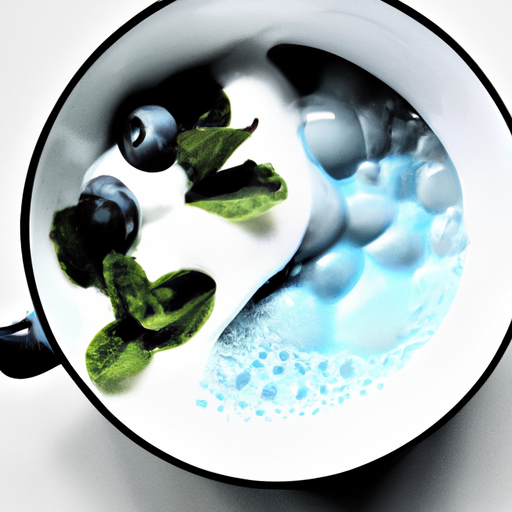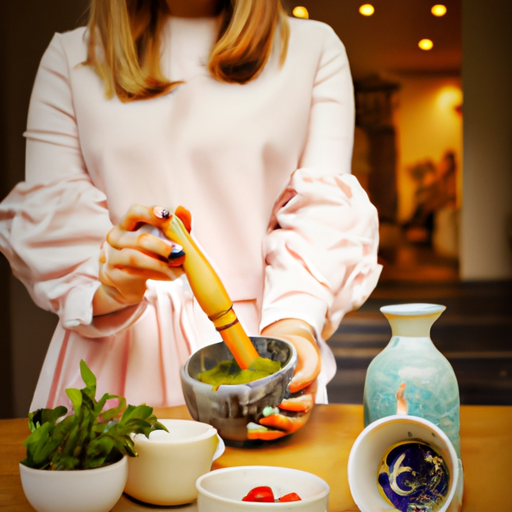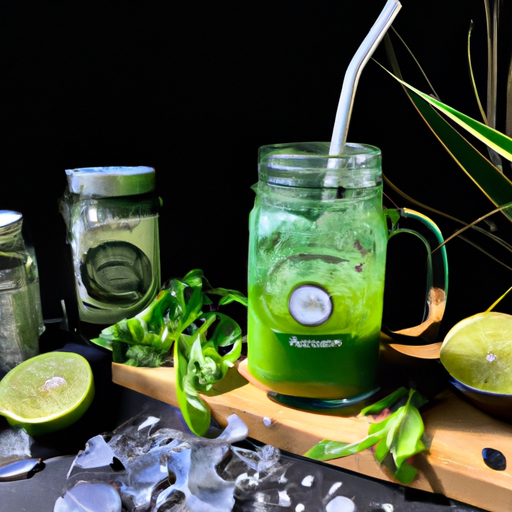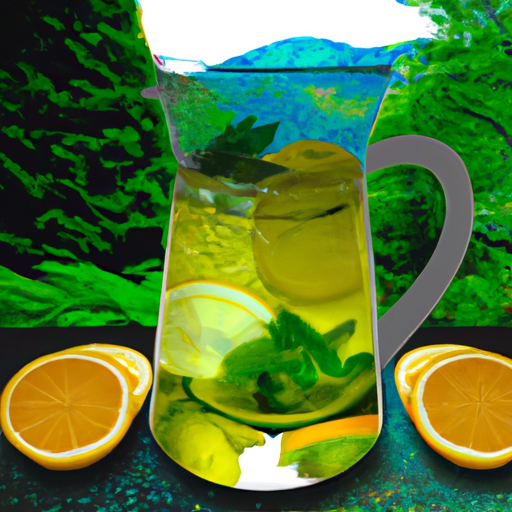As someone passionate about tea, I’ve grown to value the subtle details and variations among different teas, as well as the tools used to make them. The matcha bowl is one utensil that has particularly piqued my interest.
At first glance, it may seem like just a simple ceramic bowl, but it holds a significant place in the world of tea culture. To understand the importance of a matcha bowl, it is essential to understand the tea itself.
Matcha is a powdered green tea that originated in Japan and is known for its vibrant color and earthy flavor. It is a unique tea in that the whole tea leaf is consumed rather than just the brewed water. The preparation of matcha requires specific utensils, and the matcha bowl is one of them.
It is not just any bowl; it is a vessel that holds the essence of the tea and the culture surrounding it.
Key Takeaways
- Matcha bowls are an essential part of the traditional Japanese tea ceremony, with over 200 known styles available.
- The bowls are meticulously crafted by skilled artisans and hold deep cultural significance in Japan.
- They can be used for more than just drinking matcha and can have significant value, making them a beautiful and meaningful addition to any tea-drinking experience.
- Proper care and attention should be given to the bowl, including cleaning with warm water and a soft cloth, to maintain its beauty and functionality.
Definition of Matcha Tea
If you haven’t tried matcha tea yet, you’re seriously missing out on a delicious and invigorating beverage! Matcha tea is a fine powder that is made from shade-grown tea leaves. It is commonly used in Japanese tea ceremonies and has become increasingly popular worldwide due to its unique flavor and numerous health benefits.
Matcha tea has a long and rich history that dates back to the Tang Dynasty in China. Originally, it was used in the Chinese Song Dynasty as a medicine, and then it was introduced to the Japanese in the 12th century. The production of matcha tea has remained largely the same since its inception, with the tea leaves being carefully harvested and then steamed, dried, and ground into a fine powder.
The production process of matcha tea is what sets it apart from other types of tea. Matcha tea is made from the highest quality tea leaves, which are carefully selected and then shaded for several weeks before they are harvested. The shading process helps to increase the chlorophyll content in the leaves, giving them a vibrant green color and a unique flavor.
After the leaves are harvested, they are steamed to stop the oxidation process, and then dried and ground into a fine powder.
As you can see, the history and production of matcha tea are fascinating and complex. Now that we’ve covered the basics of matcha tea, let’s dive deeper into the origins of this beloved beverage.
Origins of Matcha Tea
You may be surprised to learn that the origins of this beloved tea can be traced back to the Tang Dynasty in China. It was during this time that tea leaves were steamed and then formed into bricks for easy storage and transportation. These tea bricks were then ground into a fine powder and whisked with hot water to create a frothy, flavorful beverage. This method of preparing tea eventually made its way to Japan, where it evolved into the matcha tea we know and love today.
History tells us that Zen Buddhist monks were the first to introduce matcha tea to Japan in the 12th century. They brought with them the tea seeds and cultivation techniques from China and began growing the tea in Japan. The monks found that the caffeine and amino acids in matcha provided a calming effect, which helped them during meditation. Eventually, matcha tea became popular among the aristocracy and samurai warriors, and it became an important part of Japanese culture.
The cultivation of matcha requires a lot of attention and care. The tea plants are grown in the shade for several weeks before they are harvested, which allows them to produce more chlorophyll and amino acids. The leaves are then steamed, dried, and ground into a fine powder using granite mills. The entire process can take several hours, but it is necessary to produce the high-quality matcha that is prized around the world.
As we have learned about the history and cultivation of matcha tea, it is important to note that the materials used for matcha bowls play an important role in the overall tea-drinking experience.
Materials Used for Matcha Bowls
Using a traditional Japanese ceramic bowl to sip on the frothy, vibrant-green tea creates a sense of cultural immersion and elevates the matcha-drinking experience.
Matcha bowls, or chawan, are typically made from either clay or ceramic. Clay bowls are often preferred for their porous nature, which allows them to absorb some of the tea’s flavor, resulting in a richer and more complex taste. On the other hand, ceramic bowls are known for their durability and ease of cleaning, making them a popular choice for modern matcha enthusiasts.
Traditional matcha bowls are typically handmade by skilled artisans using traditional techniques. These bowls often have a unique, imperfect shape and may feature intricate designs or patterns.
Modern matcha bowls, on the other hand, are often mass-produced using modern manufacturing techniques. While these bowls may lack the character and individuality of traditional bowls, they are often more affordable and readily available.
When choosing the right matcha bowl, it’s important to consider your personal preferences and the type of experience you want to have. If you value the cultural significance and history of matcha, a traditional clay bowl may be the best choice for you. However, if you prioritize convenience and durability, a modern ceramic bowl may be a better fit.
Ultimately, the perfect matcha bowl is one that enhances your connection to the tea and enhances your overall enjoyment of the ritual.
Choosing the Right Matcha Bowl
When choosing a matcha bowl, there are several considerations to keep in mind. First, think about the size and shape of the bowl. A larger bowl may be better for making larger amounts of matcha, while a smaller bowl may be more suitable for personal use. Additionally, the shape of the bowl can affect the way the matcha is whisked and the overall drinking experience.
Second, consider your personal style and preference. Matcha bowls come in a variety of designs and colors, so choose one that matches your taste and personality.
Finally, make sure to select a high-quality bowl made from durable materials to ensure it lasts for years to come.
Considerations for Size and Shape
Size and shape are important factors to consider when choosing a matcha bowl as the traditional Japanese chawan typically measures around 4 inches in diameter and 3 inches in height. However, there are various size options available in the market that cater to different needs. Larger bowls, for instance, are recommended for whisking a larger amount of matcha for multiple servings. On the other hand, smaller bowls are ideal for personal use and can provide a more intimate and focused tea-drinking experience.
In addition to size, the shape of the bowl can also affect the taste and texture of the matcha. Bowls with a wider base and shallower depth are better for whisking the matcha, as the wider surface area allows for easier whisking. Meanwhile, deeper and more narrow bowls are better for retaining heat, which is ideal for colder climates or winter months. To further explore the different sizes and shapes available, refer to the table below for a quick guide on how they can affect your matcha experience.
| Size/Shape | Purpose | Ideal Matcha Type |
|---|---|---|
| Small & round | Personal use | High-quality matcha, ceremonial grade |
| Large & round | Multiple servings | Culinary grade matcha |
| Shallow & wide | Easy whisking | All types of matcha |
| Deep & narrow | Heat retention | Lower-quality matcha, casual drinking |
When choosing a matcha bowl, it is important to consider both size and shape to ensure that the bowl can meet your personal needs and preferences. However, personal style and preference also play a role in the decision-making process, which will be discussed in the next section.
Personal Style and Preference
To truly personalize your matcha experience, you’ll want to explore your unique preferences and style when it comes to choosing a chawan.
One of the most exciting aspects of choosing a matcha bowl is the personalization options that are available. From traditional Japanese designs to contemporary styles, there are many different chawans to choose from that can reflect your personality and taste.
In addition to the aesthetic appeal, the cultural significance of the chawan should also be considered. The matcha bowl has a rich history and plays an important role in the Japanese tea ceremony.
By choosing a chawan that resonates with you, you are not only expressing your personal style, but also paying homage to this cultural tradition. With so many options available, taking the time to find the perfect matcha bowl can truly enhance your overall matcha experience.
Now, let’s explore how to use a matcha bowl.
How to Use a Matcha Bowl
When I use my matcha bowl, I always start by measuring and sifting the matcha powder to ensure it’s evenly distributed and free of clumps.
Then, I add the appropriate amount of water and whisk the mixture vigorously until it becomes frothy and smooth.
Finally, I serve the tea in a traditional manner, sipping slowly and savoring the unique flavor and texture of the matcha.
With a little practice and attention to detail, anyone can learn to use a matcha bowl to make a perfect cup of matcha tea every time.
Measuring and Sifting Matcha Powder
As I prepare my matcha in my beautiful matcha bowl, I always remind myself of the importance of measuring and sifting the powder. This crucial step ensures that the matcha powder is evenly distributed and free of clumps, resulting in a smooth and flavorful cup of tea.
To achieve this, I use measuring spoons and a sifter to ensure accuracy and consistency in my measurements. There are different measuring techniques and types of sifters to choose from, depending on personal preference. Some popular measuring techniques include using a teaspoon or a bamboo spoon, while some types of sifters include a fine mesh strainer or a traditional Japanese matcha sifter called a chasen.
Whichever technique or tool you choose, always remember to sift the matcha powder before adding it to your bowl to avoid any lumps or uneven texture. Now that the matcha powder is properly measured and sifted, it’s time to add water and whisk the tea to perfection.
Adding Water and Whisking
Now that we’ve measured and sifted the matcha powder, it’s time to add water and start whisking. Adding water to matcha powder is an important step in the preparation process as it helps to bring out the flavor and aroma of the tea.
There are a few different techniques for adding water, but generally, the water should be heated to around 175°F and poured over the matcha powder in a slow and steady stream. Once the water has been added, it’s time to start whisking.
Whisking the matcha powder and water together creates a frothy, creamy texture that is essential to the matcha experience. There are different whisking methods to choose from, but the most traditional method is to use a bamboo whisk called a chasen.
This whisk is made up of many thin, flexible tines that help to create a smooth, consistent texture. By whisking in a W-shape motion, starting from the center of the bowl and moving outwards, the matcha powder and water will combine to create a beautiful, frothy tea.
As we finish whisking, we can see the vibrant green color of the matcha and the frothy texture that we have created. Now that our matcha is fully prepared, it’s time to move on to the next step: serving and drinking matcha tea.
Serving and Drinking Matcha Tea
To enjoy your freshly whisked matcha tea, you can pour it into a small cup and savor its rich, smooth flavor.
When serving matcha tea, there are a few etiquette guidelines to follow. Firstly, it’s customary to offer the cup with both hands to show respect and gratitude towards the person serving you. Secondly, it’s polite to take a small sip before setting the cup down, as a gesture of appreciation for the tea and the person who prepared it. Finally, when drinking matcha tea, it’s recommended to sip it slowly and savor its unique flavor and texture.
Aside from its delicious taste, matcha tea is also known for its numerous health benefits. It’s packed with antioxidants, which help to reduce inflammation and protect against cellular damage. Matcha also contains caffeine, which can increase energy levels and improve mental alertness. Additionally, matcha tea has been shown to promote relaxation and reduce stress levels. By incorporating matcha into your daily routine, you can enjoy both its delicious taste and its many health benefits.
When caring for your matcha bowl, it’s important to handle it with care to avoid any cracks or chips. One way to prevent damage is to avoid using metal utensils, as they can scratch the surface of the bowl. Instead, use a bamboo whisk or spoon to prepare and serve your matcha tea.
By taking good care of your matcha bowl, you can enjoy its beauty and functionality for years to come.
Caring for Your Matcha Bowl
Properly caring for your matcha bowl is crucial to ensure its longevity and keep it looking as good as new, just like taking care of your car can keep it running smoothly for years to come.
When it comes to cleaning your matcha bowl, it’s important to avoid using any harsh chemicals or abrasive materials that can scratch or damage the delicate surface. Instead, opt for a gentle cleaning method using warm water and a soft cloth. If necessary, you can also use a mild dish soap, but be sure to rinse thoroughly to remove any residue.
After cleaning, it’s important to properly store your matcha bowl to avoid any potential damage. Always store your bowl in a cool, dry place, away from direct sunlight or heat sources. If you have multiple bowls, it’s a good idea to stack them carefully, with a soft cloth or paper towel in between to protect them from scratches. Additionally, you may want to consider investing in a protective case or bag to keep your matcha bowl safe during travel or storage.
Taking the time to properly care for your matcha bowl can help ensure its longevity and keep it looking great for years to come. By following these simple cleaning tips and storage suggestions, you can enjoy your matcha bowl for many tea ceremonies to come.
Speaking of tea ceremonies, if you’re interested in starting your own matcha bowl collection, there are many beautiful and unique options available to suit your personal taste and style.
Matcha Bowl Collections
As someone who’s been practicing the art of tea ceremony for several years, I love collecting matcha bowls.
Each one is unique and has its own story to tell.
Some bowls are incredibly valuable due to their rarity or historical significance, while others are simply beautiful pieces of art that I enjoy using in my daily tea practice.
Regardless of their value, each matcha bowl in my collection holds a special place in my heart.
Collecting Matcha Bowls
If you’re looking to elevate your matcha drinking experience, consider adding a few unique matcha bowls to your collection. Matcha bowls come in a variety of styles, ranging from antique to modern, each with its own cultural significance.
Here are four reasons why collecting matcha bowls is worth considering:
-
Aesthetic Appeal: Matcha bowls are often handcrafted and come in a variety of unique designs and colors, making them a beautiful addition to any collection.
-
Cultural Connection: Matcha bowls have a deep cultural significance in Japan and are often used in traditional tea ceremonies. By collecting them, you can connect with the history and traditions of this ancient drink.
-
Versatility: Matcha bowls can be used for more than just drinking matcha. They can be used as decorative pieces or even as serving bowls for small snacks or desserts.
-
Investment Potential: Depending on the rarity and age of the matcha bowl, they can have significant value and can be a worthwhile investment for collectors.
With these reasons in mind, it’s clear that collecting matcha bowls can be a rewarding experience. However, it’s important to note that the value and rarity of matcha bowls can vary greatly, which we’ll explore in the next section.
Value and Rarity of Matcha Bowls
You’ll be surprised by the varying worth and scarcity of different matcha bowl types, making it an intriguing aspect of collecting.
Some matcha bowls, such as those made by renowned ceramic artists, can fetch thousands of dollars at auction. The rarity of certain designs and patterns also adds to the value of the bowl. For example, bowls made during the Edo period are highly sought after because they’re considered to be the golden age of Japanese ceramics.
When collecting matcha bowls, it’s important to consider their value and rarity, as they can greatly affect the overall worth of a collection. However, it’s also important to remember that the true value of a matcha bowl lies in its historical and cultural significance, as well as its ability to enhance the enjoyment of the tea ceremony.
Understanding the value and rarity of matcha bowls is just one aspect of appreciating the rich history and tradition of matcha and tea culture.
Matcha Bowl and Tea Culture
You can’t fully experience the beauty of Japanese tea culture without a stunning matcha bowl that will make you feel like you’re sipping tea in a serene Japanese garden. The matcha bowl is not just a mere drinking vessel, but rather a symbol of the cultural significance of tea ceremonies in Japan. These bowls are meticulously crafted by skilled artisans and are considered to be important heirlooms that are passed down through generations.
Matcha bowls come in various sizes, shapes, and colors, each with their own unique design and significance. In fact, there are over 200 known styles of matcha bowls, each with a distinct name and origin. The most popular style is the chawan, which is a wide and deep bowl that allows for the perfect whisking of matcha tea. The design of the chawan is meant to evoke a sense of tranquility and harmony, which is essential to the tea ceremony.
To fully appreciate the beauty and significance of matcha bowls, it’s important to understand their history and cultural significance. The art of the tea ceremony has been practiced in Japan for centuries and is deeply rooted in the country’s history and traditions. The matcha bowl is an integral part of this ceremony and is used to serve and drink the frothy green tea that is the centerpiece of the ceremony. By incorporating a stunning matcha bowl into your tea-drinking experience, you can truly immerse yourself in the rich cultural heritage of Japan.
| Name | Origin | Design | Significance | Popular Style |
|---|---|---|---|---|
| Hagi | Hagi, Japan | Rustic, earthy tones | Represents simplicity and humility | Chawan |
| Kutani | Kutani, Japan | Intricate, colorful designs | Symbolizes beauty and elegance | Chawan |
| Raku | Kyoto, Japan | Unique, handcrafted designs | Signifies impermanence and uniqueness | Yunomi |
| Karatsu | Karatsu, Japan | Minimally decorated, natural clay colors | Represents tranquility and calmness | Chawan |
| Shino | Mino, Japan | White glaze with small cracks and imperfections | Symbolizes the beauty of imperfection | Chawan |
As you can see, each matcha bowl style has its own unique story and significance. By incorporating a matcha bowl into your tea-drinking routine, you are not only adding beauty to your experience, but also immersing yourself in the rich cultural heritage of Japan. So next time you sip on a frothy cup of matcha, take a moment to appreciate the beauty and cultural significance of the humble matcha bowl.
Frequently Asked Questions
How does the shape of a matcha bowl affect the taste of the tea?
When it comes to matcha tea, the shape of the bowl can actually affect the taste perception. Bowl shape effects can be subtle, but they can still impact the overall experience.
For example, a wider bowl can allow for more oxygen to mix with the tea, which can enhance the flavor. On the other hand, a narrower bowl can concentrate the aroma, creating a stronger scent.
Additionally, the depth of the bowl can affect the temperature of the tea. A shallower bowl may result in a cooler tea, while a deeper bowl can keep the tea hotter for longer.
Ultimately, choosing the right matcha bowl comes down to personal preference and finding the shape that produces the desired taste and aroma.
Can matcha bowls be used for other types of tea or beverages?
I once visited a tea shop that had a variety of tea alternatives to matcha, but they only served them in matcha bowls.
At first, I was skeptical that the unique shape of the bowl would affect the taste of the tea, but the shop owner explained that matcha bowl accessories are versatile and can be used for any type of tea or beverage.
The wide, shallow design of the bowl allows for the aroma of the tea to be fully appreciated, while the small size encourages sipping and savoring each sip.
Additionally, the shape of the bowl makes it perfect for mixing in sweeteners or flavorings.
So, while a matcha bowl may be traditionally associated with matcha, it can be used for any hot beverage, making it a great addition to any tea lover’s collection.
Is it safe to use a matcha bowl in the microwave or dishwasher?
When it comes to using a microwave for matcha bowls, there are both pros and cons to consider. On the positive side, it can be a quick and convenient way to warm up your matcha or other beverages.
However, it’s important to note that not all matcha bowls are microwave-safe, so you should always check the manufacturer’s instructions before attempting to use them in this way. Additionally, microwaving your matcha bowl can cause it to heat unevenly or even crack, so it’s best to use caution and monitor it closely while heating.
As for cleaning your matcha bowl, some people may prefer to use a dishwasher, but it’s important to note that some materials or finishes may not be dishwasher-safe. As an alternative, you can hand wash your matcha bowl with warm water and a mild detergent, being careful not to scrub too vigorously or use any abrasive cleaners that could damage the surface.
Ultimately, taking care with your matcha bowl, whether you opt for the microwave or hand washing, will help to ensure that it lasts for years to come.
How do you know if a matcha bowl is authentic or just a cheap imitation?
When it comes to identifying an authentic matcha bowl, there are a few key indicators to look out for.
Firstly, the historical significance of the bowl can offer some insight into its authenticity. Traditional matcha bowls, known as chawan, have been used in Japan for centuries and have a distinct style and shape.
Additionally, authentic bowls are often handmade and have slight variations in shape and color due to the nature of the crafting process.
Finally, the quality of the materials used can also be a factor in determining authenticity, with true matcha bowls typically made from high-quality ceramics or stoneware.
It’s important to be aware of these authenticity indicators when purchasing a matcha bowl to ensure you’re getting a high-quality, traditional piece rather than a cheap imitation.
What is the significance of the different colors and designs on matcha bowls?
When it comes to matcha bowls, the different colors and designs hold significant meaning in Japanese culture. In the traditional tea ceremony, the bowl is not just a vessel for serving tea, but also a work of art that reflects the host’s personality and taste.
The colors and patterns on the bowl can convey certain messages or evoke specific emotions. For example, a bowl with a blue or green glaze might represent nature and tranquility, while a bowl with a bold red design could symbolize energy and passion.
Additionally, some bowls are designed to complement the season or occasion, with cherry blossom motifs for spring or snowflake patterns for winter. Overall, the matcha bowl is a key element in the tea ceremony and an important expression of Japanese aesthetic values.
Conclusion
In conclusion, as a Matcha enthusiast, I can’t stress enough the importance of having the perfect Matcha bowl.
The moment you lay eyes on your beautifully crafted Matcha bowl, it will evoke a sense of calmness, and you’ll feel the weight of history and tradition.
Holding it in your hands and feeling its smooth texture will transport you to ancient Japan, where Matcha tea was first enjoyed by Buddhist monks.
The sound of the whisk as you froth your Matcha tea in your bowl will create a symphony of delicate notes, and the aroma of the tea will fill your senses.
The Matcha bowl is not just a vessel for tea, but a symbol of the tea culture that has been passed down for generations.
So, invest in a Matcha bowl that speaks to you, and embrace the ritual of Matcha tea with all your heart and soul.










